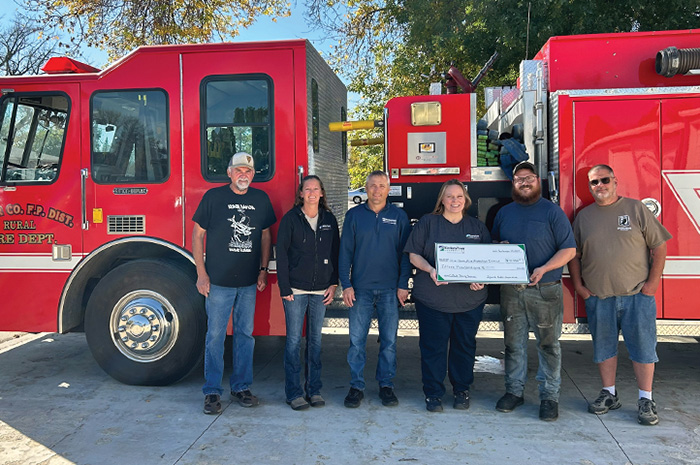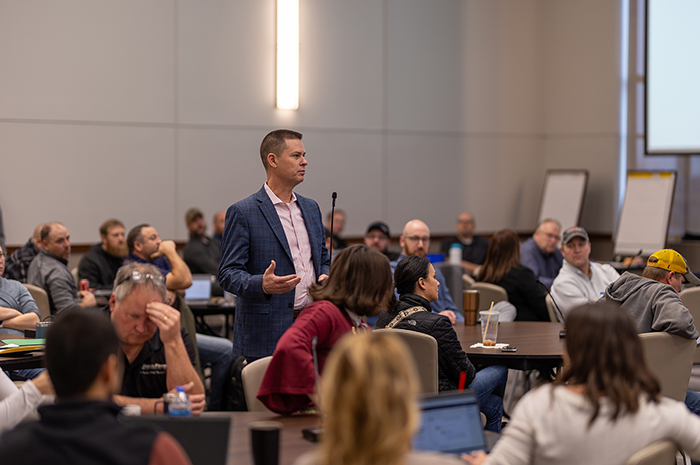Revamped to recycle
Six Minnesota counties are now bringing their garbage to a unique and efficient waste and recyclable material processing facility in Fosston.
Jon Steiner likes to tell the story about a county commissioner from outside their partnership group who came to see the Polk County Solid Waste Management facility in Fosston, Minn. Steiner manages the facility as Polk County’s environmental services administrator.
Fosston is home to six counties’ regional waste and recyclable material processing facility that was just recently expanded and upgraded. The commissioner wanted to check out how the new optical sorters worked. The optical sorters are a series of machines that use light beams to scan materials which pass under them to detect what kind of plastic they are made from.
If it detects the type of plastic it’s programmed to eject, it triggers a burst of air to blow the item onto a specific conveyor belt. Each conveyor belt carries a different type of plastic to individual bins to be baled and marketed.
It takes the optical scanner a millisecond to make each decision.
Because the new equipment wasn’t up and running, Steiner asked one of the equipment installers to turn the first optical sorter on to test it for the commissioner. He grabbed a few nearby plastic soda bottles and threw them on the conveyor belt to show the commissioner how the system works.
“We fired up the machine for him,” Steiner said. “It was dead quiet in here. We put the pop bottles on the belt and watched them going zipping down the line. It sounded like a .22 going off, a loud crack and all you could see was dust off the bottle.”
The commissioner watched each plastic bottle go down the conveyor and disappear in a cloud of dust.
“He kept insisting they were being disintegrated. We had to show him, walk him around to the backside where you could see the bottles coming out on that quality control line. He thought for sure we were destroying them.”
Not a lot is destroyed at the Polk County Materials Recovery Facility, which handles recycling and garbage for Polk County and five other counties – Beltrami, Clearwater, Hubbard, Mahnomen and Norman. Large items such as couches and beds are sent to the landfill down the road.
.jpg)
Polk County’s operation is an innovative way to deal with garbage. In addition to sorting waste that residents have recycled, it pulls recyclables out of waste and turns leftover garbage into energy. The management and disposal of waste has changed over the years. Small community dumps and burn pits have given way to high-tech regional material recovery facilities and waste-to-energy incineration plants like the Polk County facility, which is the second-largest customer for Fosston Municipal Utilities.
Steiner said 20% to 25% of the material that comes in the door at the Polk County site gets used again or recycled. Recycled materials are sold; what’s left is incinerated. The resulting ash is hauled to the Polk County Sanitary Landfill in Gentilly, where it is stockpiled, screened and reused in road construction projects.
The incinerator part of the process isn’t new. It’s been burning trash for decades. The steam from waste combustion is sold to businesses in the Fosston industrial park. Similar waste processing and combustion operations are also located in Minnesota, with the idea that it will be less expensive in the long term to recycle more materials from the trash and then burn the remaining waste for energy.
The nearly $11 million facility expansion and upgrade has allowed it to speed up its process and pull clean cardboard, aluminum and ferrous metals and multiple types of plastic containers out of garbage. The same equipment also is used to process recyclable materials, and another optical sorter is used to clean paper to be recycled. Steiner said it’s the only facility in the state that uses the same equipment to sort recycling and garbage.
“We chose equipment that worked for the garbage and then adapted it back for the recyclables,” Steiner said. “It does the same thing.”
.jpg)
To upgrade the equipment and process additional materials Polk County added an 18,000-square-foot building addition, which included space for incoming materials and the new equipment.
“The one unique thing with our project is we kept operating all through construction, so it slowed the construction process down when we were trying to work around things and trying to replace equipment while we were backing trucks up and pulling trucks out,” Steiner said. “It’s a lot easier to have a blank canvas.”
Steiner said Polk County waste has added six to seven employees over the last several years in anticipation of the new equipment and processes, and needs to add a few more. After about a year and a half of construction, the new equipment went live on Dec. 5, 2018.
The Polk County facility can now process more material, process it faster and deliver a cleaner recyclable material, which is important when the waste and markets are continually changing.
Main image: Jon Steiner shows how garbage travels by conveyor in the Polk County Materials Recovery Facility. (Kevin Jeffrey/Minnkota)
...



